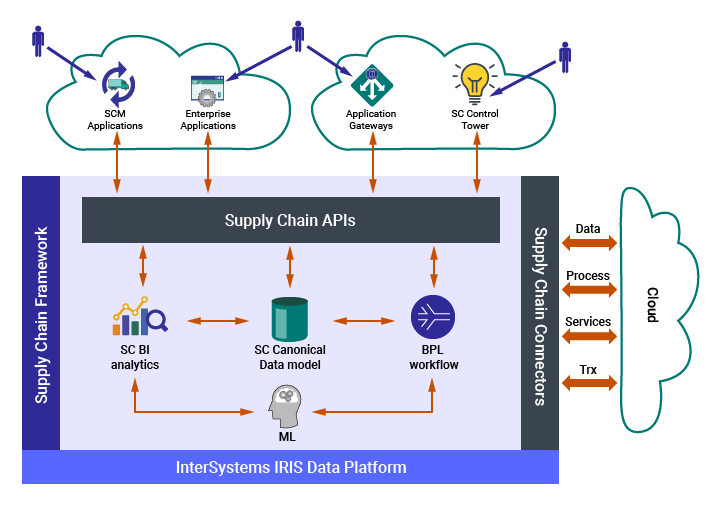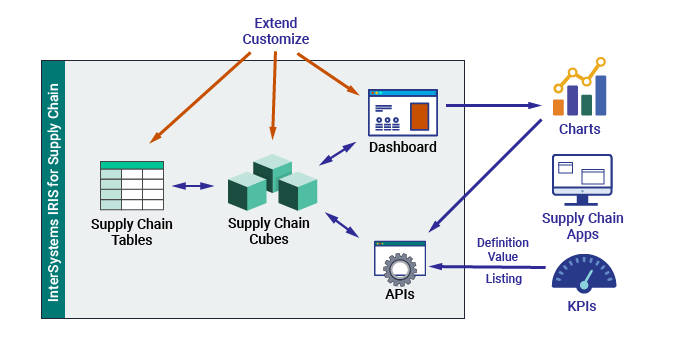Introduction to InterSystems Supply Chain Orchestrator
InterSystems Supply Chain Orchestrator™ provides an intelligent data platform together with a set of supply-chain-specific cloud services to provide end-to-end visibility and unmatched predictive and prescriptive capabilities that transform supply chain performance and agility.
The core part of Supply Chain Orchestrator is named InterSystems IRIS for Supply Chain, which consists of InterSystems IRIS® and the separately released InterSystems Supply Chain Framework. As shown in the figure below, the Supply Chain Framework extends key parts of InterSystems IRIS.
In addition to this core, a series of cloud services are planned. Customers and partners can also create and market their own cloud services to interoperate with this ecosystem.

Purpose of Supply Chain Orchestrator
Supply Chain Orchestrator is designed to meet the following objectives:
-
Provide the basic infrastructure required for most supply chain problems, such as supply-chain-wide KPIs and issue management.
-
Provide common supply chain features, such as supply chain data model and related analytics cubes.
-
Provide a set of APIs to access supply chain capabilities, which can be easily used for external consumption such as UI development.
-
Provide a set of utilities which make the adoption of the framework easy. For example, messaging capabilities and helper classes are provided to simplify business process design to achieve no-code or low-code development.
Supply Chain Orchestrator is not:
-
A supply chain solution to replace any existing supply chain operation applications, such as TMS, WMS, or OMS. The product does, however, make it easy to connect data and/or processes from these systems, bridge data visibility gaps, and provide intelligent actions to minimize risk impacts on the overall supply chain.
-
A predefined set of solutions for specific use cases, such as business processes or business rules for any use case, or KPIs for any part of the supply chain. The product does provide simple mechanisms for you to define your own use case specific solutions with minimum or no coding effort.
-
An end-user application for supply chain practitioners to interact with directly. The solution or outcome from the framework is expected to be exposed to other applications, such as a control tower UI, a BI tool, or other supply chain applications.
Features
Supply Chain Orchestrator (specifically the core part, IRIS for Supply Chain) provides the following features:
-
Extensible supply chain data model, a canonical supply chain data model implemented on InterSystems IRIS data platform, which can be extended/customized using either ObjectScript code or APIs.
-
Data model APIs for data model discovery and live documentation, such as listing all supply chain data objects, or getting the detailed definition of a supply chain data object.
-
Data access APIs, which support both CRUD operations and advanced search capabilities with sorting and pagination support.
-
Analytics cubes, prebuilt Business Intelligence cubes based on the supply chain data model. The built-in cubes can be extended as needed, for example to include custom attributes.
-
KPI framework and related APIs, support for KPI management (KPI configurations and life cycle management) and KPI values and listings access. The current KPI framework is based on the predefined analytics cubes.
-
Issue life cycle management, the component which is responsible for issue identification, issue analysis, and action recommendations.
Architecture Overview
The core of Supply Chain Orchestrator is InterSystems IRIS for Supply Chain (an InterSystems IRIS® server with the addition of the InterSystems Supply Chain Framework), as shown above. The following figure shows more detail:

The next picture shows the analytics support in more detail:

Available Online Learning
In addition to the documentation websiteOpens in a new tab, see the online learning path Building Smart Real-Time Supply Chain ApplicationsOpens in a new tab, in which you will explore use cases and architecture of this platform and learn how to install and start implementing it. You will also learn to create KPIs and use business logic for issue resolution.